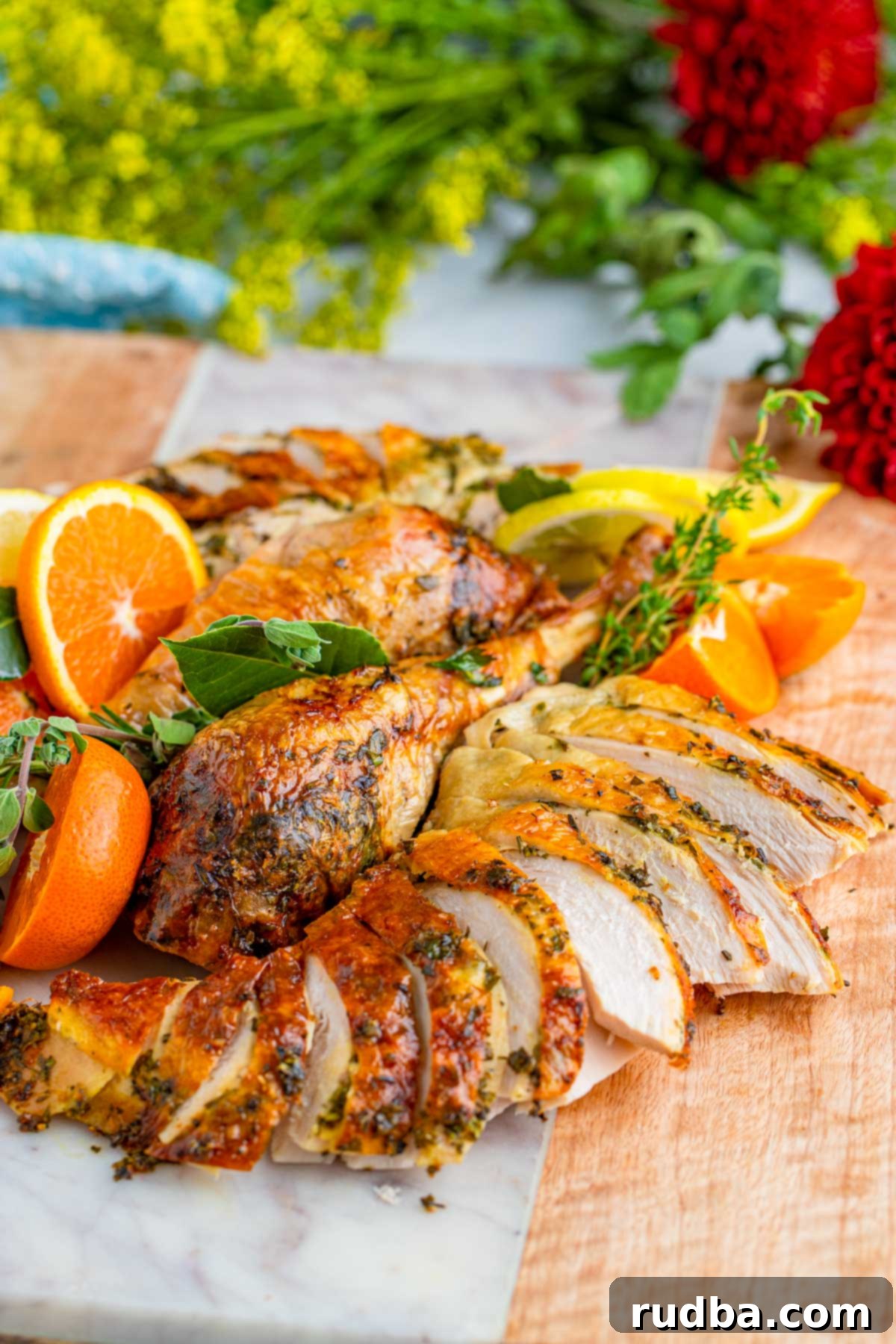The Ultimate Guide to a Perfectly Juicy Roast Turkey for Thanksgiving
Impress friends and family with this absolutely delicious and incredibly juicy Roast Turkey. This recipe takes a blend of savory herbs, combines them with softened butter, and coats the entire turkey for maximum flavor and moisture. It’s then slow-roasted to golden-brown perfection, ensuring your Thanksgiving or holiday feast is a truly memorable success. Forget dry, bland turkey – this recipe guarantees a tender, flavorful bird every time!
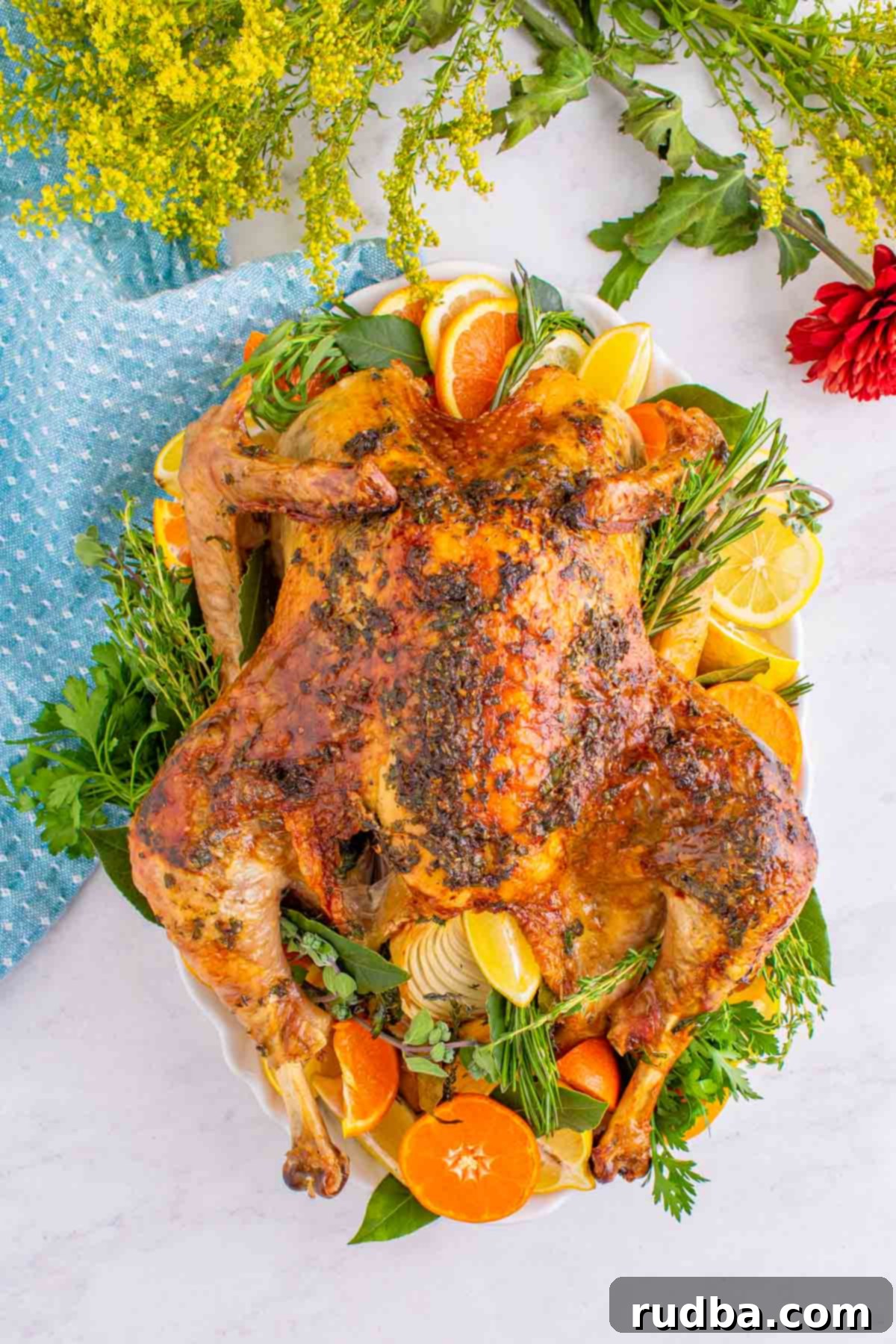
Thanksgiving holds a special place in my heart, sitting right at the top of my list for cherished holidays. It’s a beautiful time dedicated to celebrating food, embracing family, and practicing gratitude. There’s an undeniable peace in the air, a comforting warmth that fills our homes, and an opportunity to create treasured memories with the ones we love most.
And let’s be honest, the food aspect of Thanksgiving truly gets me excited! It’s an annual culinary event where all my favorite dishes make an appearance. I eagerly anticipate the moment I can start preparing classic holiday sides like the creamy Sweet Potato Casserole, sweet and tender Candied Yams, rich Green Bean Casserole, cheesy Baked Mac and Cheese, and delightful Garlic Parmesan Dinner Rolls.
Of course, amidst all these wonderful side dishes, who could ever forget the undisputed star of the Thanksgiving show? The magnificent Roast Turkey. For many home cooks, preparing the holiday turkey can feel like the most daunting and stressful part of the meal, with the pressure to achieve absolute perfection. No one wants to present a dry, unappetizing turkey at the center of their festive table. However, with this incredibly straightforward and foolproof turkey recipe, you can banish those worries! It consistently delivers a wonderfully delicious roast every single time, featuring perfectly crispy, golden-brown skin on the outside and exceptionally flavorful, juicy meat on the inside.
How To Make Your Juicy Roast Turkey
Achieving a perfectly cooked, moist turkey is simpler than you might think. Follow these easy steps to prepare your show-stopping holiday centerpiece:
- Prep Your Turkey – Begin by preheating your oven to 325 degrees Fahrenheit (160°C). Carefully remove any giblets and the neck from the turkey cavity and discard them. Gently massage the turkey skin to help loosen it, which will make it easier to apply the butter mixture. Pat the entire turkey thoroughly dry with paper towels; this crucial step promotes a wonderfully crispy skin.
- Season the Turkey with Herb Butter – In a medium-sized bowl, combine the softened unsalted butter with all the finely chopped fresh herbs (parsley, thyme, rosemary, sage, tarragon) and minced garlic. Mix these ingredients thoroughly until they form a fragrant, well-blended compound butter. Carefully rub about two-thirds of this flavorful butter mixture *underneath* the turkey skin, working it gently over the breast, legs, and thighs. This ensures the meat stays incredibly moist and flavorful from the inside out. Then, spread the remaining butter mixture generously over the *outside* of the turkey skin. Finish by seasoning the entire turkey liberally with kosher salt and freshly ground black pepper.
- Stuff the Cavity with Aromatics – To infuse even more flavor and moisture into your turkey, fill the cavity with aromatic ingredients. Place the lemon wedges, orange wedges, onion wedges, a halved head of garlic, and any remaining fresh herbs into the turkey’s cavity. These aromatics will steam from within, adding subtle yet impactful notes to the meat.
- Roast to Perfection and Rest – Place your prepared turkey in a sturdy roasting pan. Roast the turkey in the preheated oven for approximately 15 minutes per pound. Use a reliable meat thermometer to ensure doneness; insert it into the thickest part of the turkey thigh (without touching bone). The turkey is ready when it reaches an internal temperature of at least 165 degrees Fahrenheit (74°C). Once cooked, remove the turkey from the oven and, crucially, let it rest for at least 30 minutes before carving. This resting period allows the juices to redistribute throughout the meat, resulting in a much juicier and more tender turkey. Serve and enjoy your magnificent creation!
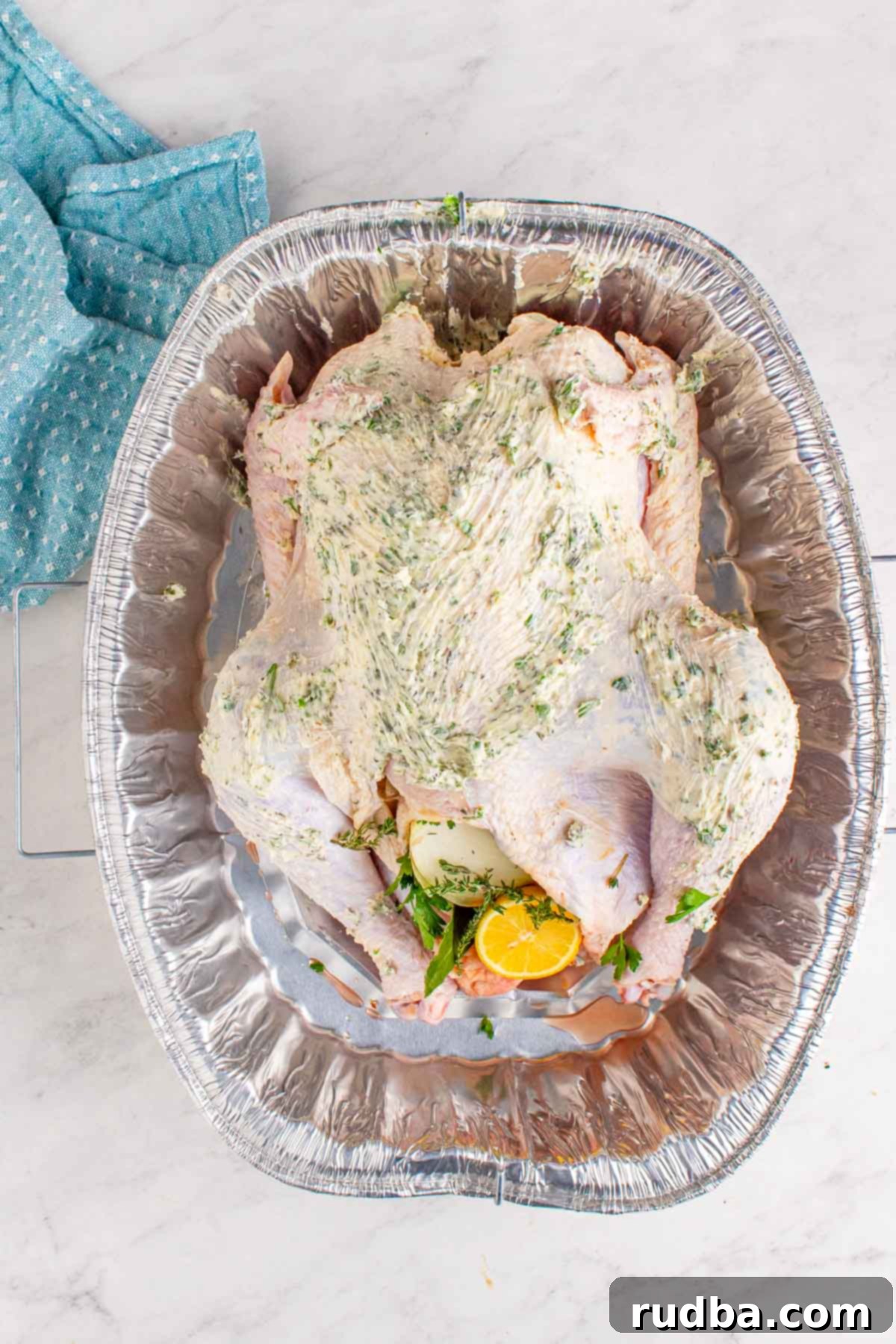
Top Tips For The Perfect Juicy Roast Turkey
Ensuring your roast turkey is moist, flavorful, and beautifully cooked doesn’t have to be a guessing game. These expert tips will help you achieve a show-stopping bird every single time:
- Make the Turkey Ahead of Time – To significantly reduce stress on Thanksgiving Day, consider preparing your turkey in advance. You can prepare it through the seasoning stage the day before, cover it tightly, and store it in the fridge overnight. On Thanksgiving morning, simply take it out of the fridge about 40 minutes before roasting to bring it closer to room temperature, then pop it in the oven. This strategy allows you to enjoy a more relaxed holiday morning without compromising on flavor or quality. Reheating a fully cooked turkey can be done gently in the oven at a low temperature, covered with foil, until warmed through.
- Thawing a Frozen Turkey Safely – Proper thawing is paramount for food safety and even cooking. Never attempt to force-thaw your turkey at room temperature or with hot water, as this can lead to uneven thawing and dangerous bacterial growth. The safest and most effective method is to thaw it in a large bowl or roasting pan in the refrigerator. A general rule of thumb is to allow approximately 1 day of thawing time for every 4-5 pounds of turkey. So, for a 20-pound turkey, you’ll need to start thawing it about 4-5 days before you plan to cook it. Plan ahead!
- Use a Meat Thermometer – Your Best Friend in the Kitchen – When cooking large cuts of meat like a whole turkey, a reliable meat thermometer is absolutely essential. It eliminates guesswork and ensures your turkey is cooked to a safe internal temperature while remaining perfectly juicy. Before removing your turkey from the oven, insert the thermometer into the thickest part of the turkey thigh, making sure it doesn’t touch any bone. The turkey is fully cooked and safe to eat when it reaches at least 165 degrees Fahrenheit (74°C). Checking the breast and wing joints is also a good practice for larger birds.
- Experiment with Other Seasonings and Herbs – While this recipe provides a fantastic base, feel free to customize the flavor profile to your preference. Don’t hesitate to incorporate other fresh or dried herbs or spice blends. The key is to always include a good amount of salt, pepper, and garlic to ensure a robust flavor foundation. Delicious seasoning ideas include Cajun seasoning for a spicy kick, Italian herbs for a Mediterranean flair, Greek seasoning, or even smoky chipotle seasoning for a unique twist.
- Stuff the Cavity with Diverse Aromatics – The ingredients used to stuff the turkey cavity are primarily for infusing flavor and moisture into the bird, not for eating as a traditional “stuffing.” While lemon, orange, onion, and garlic are excellent choices, you can certainly use other aromatics. Carrots, celery stalks, apple halves, or even fresh bundles of herbs like rosemary and thyme work wonderfully. The goal is to create an aromatic steam bath within the turkey as it roasts, adding depth and complexity to the meat.
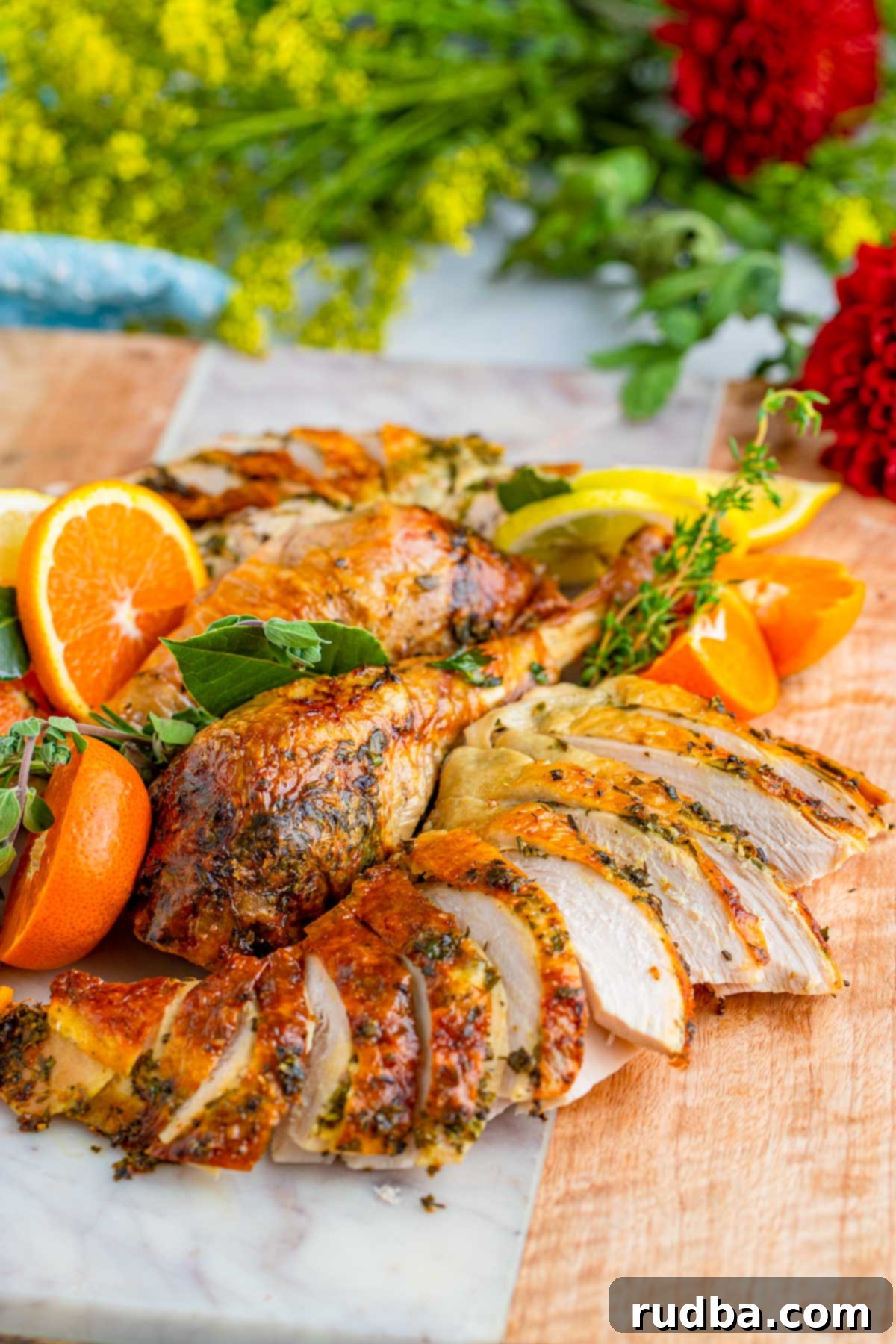
How Long Does it Take to Roast a Turkey?
The roasting time for a turkey is primarily determined by its size. A common mistake is to try and rush the process by turning up the oven heat too high, which often results in parts of the turkey cooking too quickly and drying out, while other parts remain undercooked. The best approach for a perfectly juicy roast turkey is to cook it “low and slow” at a consistent lower temperature, ideally around 325 degrees Fahrenheit (160°C).
A reliable general rule of thumb for roasting time is to allow approximately 15 minutes of cooking time per pound of turkey. So, if you have a 12-pound turkey, you would estimate about 3 hours of roasting time (12 lbs x 15 min/lb = 180 minutes). For a 20-pound turkey, plan for about 5 hours. However, these are just estimates. The most accurate way to ensure your turkey is fully cooked and safe to eat is by using a meat thermometer. Always check that the internal temperature in the thickest part of the thigh has reached 165 degrees Fahrenheit (74°C) before removing it from the oven. Remember, the turkey will continue to cook slightly (carryover cooking) once removed, and most importantly, it needs to rest! Resting is crucial for juices to redistribute, leading to an incredibly tender and moist bird.
Do You Cover Turkey When Roasting?
When it comes to roasting a turkey, the decision of whether to cover it with foil or leave it uncovered is a common point of discussion, and ultimately, it’s largely a matter of personal preference and desired outcome. Both methods have their benefits.
Covering the turkey for part of the roasting process can help prevent the skin from browning too quickly and can also help trap moisture, contributing to an even juicier interior. This is particularly useful if your turkey tends to dry out or if you want to ensure the breast meat remains extra moist. If you choose to cover your turkey, typically with aluminum foil loosely tented over it, be sure to remove the foil about 30 to 45 minutes before you anticipate the turkey being done. This critical last step allows the skin to crisp up beautifully and achieve that desirable golden-brown color that makes a roast turkey so appetizing. If you prefer a very crispy skin and find your oven cooks evenly, you might choose to leave it uncovered for the entire duration, but keep a close eye on it to prevent over-browning.
Should I Brine The Turkey?
Brining is a popular technique used to ensure a juicy and flavorful turkey, and it generally involves soaking the bird in a saltwater solution (wet brine) or rubbing it with a salt mixture (dry brine) prior to cooking. The salt helps the turkey retain moisture, resulting in a more tender and juicy final product.
While brining is a highly effective method, in this particular recipe, I believe a separate brine isn’t strictly necessary. The generous application of the herb-infused butter, especially when worked under the skin, along with the seasoning of salt and pepper all over the bird, achieves a similar goal of locking in moisture and infusing tremendous flavor. The butter creates a protective layer and bastes the turkey from the inside out as it melts, providing exceptional juiciness without the added step and space requirement of brining. However, if you are a devout briner and have the time and refrigerator space, feel free to brine your turkey beforehand – it certainly won’t hurt the outcome!
How Much Turkey Per Person?
When planning your Thanksgiving feast, a good rule of thumb for turkey portions is to estimate about 1 to 1.5 pounds of turkey per person. This measurement accounts for the bone weight and provides a very generous serving size, ensuring everyone gets enough delicious turkey and leaving room for potential leftovers. For example, a 15-pound turkey will comfortably serve approximately 10 people with ample portions. If you’re a fan of leftovers for sandwiches or future meals, lean towards the higher end of the estimate.
Let’s Talk About Stuffing and Gravy…
No Thanksgiving turkey is complete without its traditional companions: rich, savory gravy and hearty stuffing. To create an unforgettable turkey gravy, simply collect the flavorful pan drippings left over from roasting your turkey. These drippings are packed with all the delicious herb-butter and turkey juices, forming a fantastic base for your gravy. Follow your favorite gravy recipe, thickening the pan juices with a roux and seasoning to taste. For stuffing, while there are countless variations, my absolute favorite is this incredible Maple Sausage Stuffing – it’s a perfect blend of sweet and savory that complements the turkey beautifully.
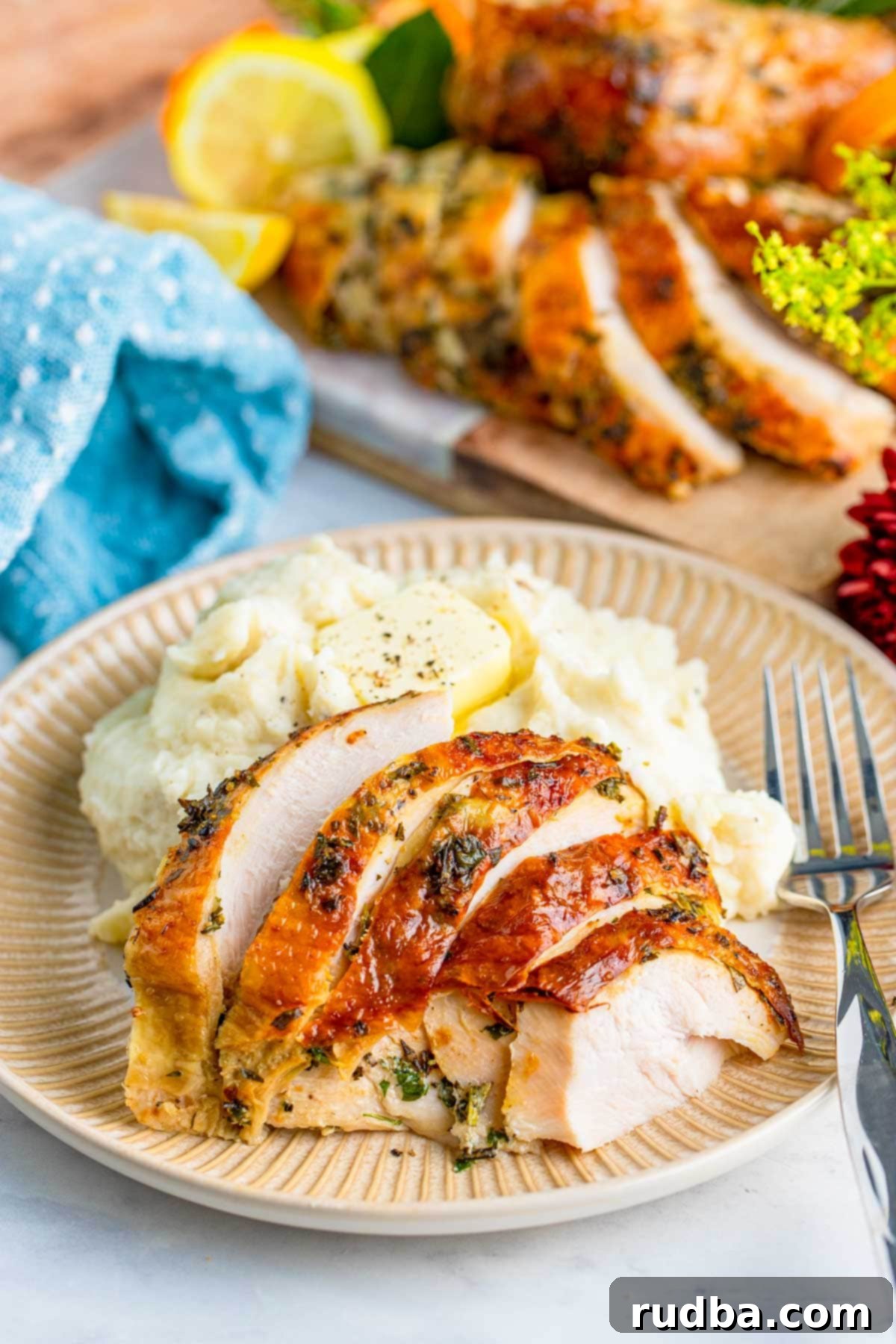
Storage
Proper storage of leftover turkey is essential for both food safety and maintaining its delicious flavor and texture. Here’s how to keep your roast turkey fresh:
- Fridge – Any leftover roast turkey should be stored in an airtight container or tightly covered with plastic wrap in the refrigerator within two hours of cooking. It will remain fresh and safe to eat for up to 3-4 days.
- Freezer – For longer storage, you can freeze cooked turkey. To do this most effectively, I highly recommend reducing the turkey to slices or shredded pieces rather than trying to freeze it whole. Place the turkey in an airtight freezer-safe container or heavy-duty freezer bags. Properly stored, it will last in the freezer for up to 2-3 months.
- Reheating – When it’s time to enjoy your leftovers, you can reheat turkey using various methods. For crispy skin and tender meat, the oven or an air fryer works wonderfully at a moderate temperature (covered to prevent drying). The microwave is a quick option for smaller portions, though it can sometimes affect texture. Always ensure the turkey is reheated to an internal temperature of 165 degrees Fahrenheit (74°C).
What to Serve this with?
The beauty of a perfectly roasted turkey is its versatility. While it’s the centerpiece of Thanksgiving, it pairs wonderfully with a wide array of side dishes. The possibilities are truly endless, but some classic and highly recommended accompaniments include rich and creamy Creamy Mashed Potatoes or delightfully sweet Mashed Sweet Potatoes – both are excellent choices that soak up all those delicious turkey juices.
Other fantastic options include roasted vegetables like Brussels sprouts or asparagus, a vibrant cranberry sauce, or a fresh green salad to balance the richness. Whatever you choose, your juicy roast turkey will be the star of the plate!
If you enjoyed mastering this juicy roast turkey recipe, you might also love exploring other delicious turkey dishes. Give these Honey Baked Turkey Wings a try for a sticky, sweet, and savory treat. These Instant Pot Smothered Turkey Wings are another favorite, offering incredibly tender meat with minimal effort! For more mouth-watering recipes and helpful cooking tutorial videos, be sure to check out Youtube and Facebook.

Juicy Roast Turkey
Save RecipeSaved Recipe
Pin Recipe
Rate Recipe
Print Recipe
Ingredients
- 12 lb whole turkey , skin-on, fully defrosted
- 1 cup unsalted butter, softened
- 3 tbsp fresh parsley, finely chopped
- 1 tbsp fresh thyme , finely chopped
- 1/2 tbsp fresh rosemary , finely chopped
- 1/2 tbsp fresh sage , finely chopped
- 1/2 tbsp fresh tarragon , finely chopped
- 5 garlic cloves , finely minced
- 1/2 tbsp kosher salt , or to taste
- 2 tsp black pepper
The Cavity
- 1 lemon, cut into wedges
- 1/2 orange , cut into wedges
- 1 small onion , cut into wedges
- 1 head of garlic , cut in half
Instructions
-
Preheat the oven to 325°F. Remove the neck and giblets from the turkey if there are any. Cut off any excess skin and discard. Using your hands, gently separate the skin from the turkey starting at the neck/breast area and work your way down to the legs and thighs, set aside.
-
In a medium-sized bowl, mix together the butter, salt, pepper, parsley, thyme, rosemary, sage, tarragon, and garlic until combined. Again, using your hands place ⅔ of the butter mixture under the skin, smoothing it out over the legs, thighs, and breast. Rub the remaining butter mixture all over the skin. Season the turkey all over with salt and pepper.
-
Stuff the cavity with the lemon, orange, onion, garlic, and any leftover herbs you have. Roast for about 15 minutes per pound until the internal temperature taken in the thickest part of the thigh reaches 165°F. Let it rest for at least 30 minutes before slicing to serve.
Notes
Nutrition
Nutrition information is automatically calculated, so should only be used as an approximation.
Additional Info
Like this recipe? Leave a comment below!
